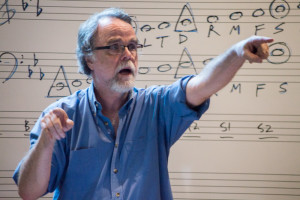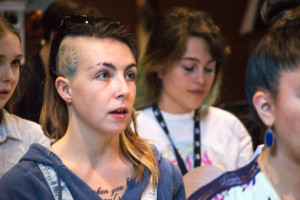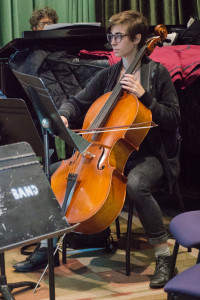Tags
Related Posts
Share This
Mooloo Colony

Head of the Mooloo Colony, Steve Paxton directs the large group of students attending his music theory course. Photo by Jennifer Rapinchuk
This semester, the Contemporary Music Program at Santa Fe University of Art and Design has a new choir, thanks to faculty member Steve Paxton and two of his music theory classes. The Mooloo Colony, as Paxton named the group, is made up of freshman and sophomore students who are currently enrolled in a music theory lab.
Coming together for a large student choir isn’t exactly a new concept for the department. When the music program first opened its doors, all of its students would meet once a week for about an hour to work. In recent years, that practice of coming together has fallen to the wayside. However, Paxton is trying to bring that practice back. “You don’t get a lot of communication at face value these days and there’s something to be said about meeting once a week with everyone,” he said.
Students were unaware until the first day that their lab would be a choral group. Though it was a surprise, the response from the students so far has been overwhelming positive. Katie Beran, a sophomore in the department, was enthusiastic about the ways the chorus would strengthen her knowledge of theory, saying “[the] choir is a great vehicle for learning sight reading, which tests not only your knowledge of theory, but your ability to transfer those concepts from class work to practical application.”

Sophomore and CMP major Katie Beran practices her music theory as she sings under Steve Paxton’s direction. Photo by Jennifer Rapinchuk
Lara White, a cellist and vocalist in the group, noted that their sight reading had become stronger and overall they had seen an improvement in the quality of their work during class. White also mentioned how exciting it was to see everyone get involved, “the new sense of community feels good,” they said.
The name of the group, The Mooloo Colony, stems from two very different inspirations in Paxton’s head. The first part, Mooloo, is a nod at the way the department used to commence its forum every week. Getting all the students who showed up involved by leading an improvisation; whether it was singing, comedy, music or a skit. The second part of the name, Colony, is a tribute to a former student, Cole Wilson, who formed a group known as The Apple Miner Colony. The group was made up of 20 to 30 students who would perform across the country. Paxton wanted the name of his current group to “honor the courage” of those alumni.
The 50-person choir is also working on a way to incorporate live instrumentation with their vocals. So far the group plans to have two cellos, one violin, a piano and an accordion, but the list is still growing.
Marcelino Juarez is one of the theory students who will be singing in the group as well as playing an instrument. Juarez is thrilled that the choir is is helping him play his accordion with live vocals, saying “because I am not usually an accompanist, playing while people are singing is really helping me improve as a musician, as playing with live vocalists is something I would like to do more of in the future.”
On Oct. 21, The Mooloo Colony has its first performance downtown Santa Fe at the San Miguel Mission. They will be teaming up with a visiting group, The California Redwood Chorale and performing a few pieces together.

In CMP’s music theory course, Lara White not only sings, but also plays their cello. Photo by Jennifer Rapinchuk
Juarez wants everyone to know that the October performance is going to be a wonderful collaboration and shouldn’t be missed. “We have a lot of talented people in the department and to have them all together in one room is just amazing. We all make each other better because each of us brings something different to the table. That being said, you won’t be disappointed. So many different instrumentalists are playing, singing, learning, and growing together, you won’t see that anywhere else.”






 Jackalope Magazine is the student magazine of Santa Fe University of Art and Design. Building on the interdisciplinary nature of our education, we aim to showcase the talent of our university and character of our city.
Jackalope Magazine is the student magazine of Santa Fe University of Art and Design. Building on the interdisciplinary nature of our education, we aim to showcase the talent of our university and character of our city.
Recent Comments